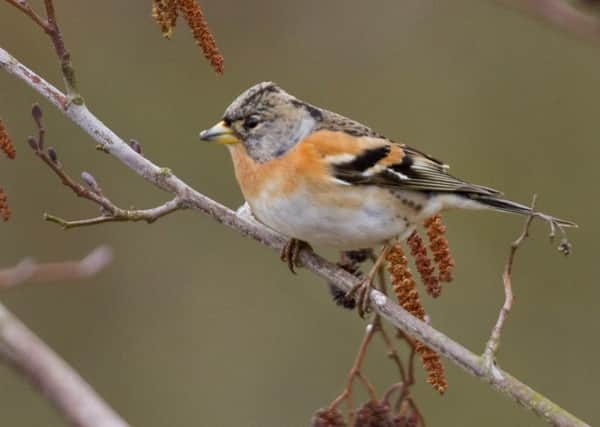Birdwatch: Fruits of the forest lure birds for winter from over the sea


They are closely related to chaffinches, but orange or peachy underneath instead of pink and with brown plumage streaked with white.
In breeding plumage the males have striking black hoods and traces of this remain in winter. Another feature to look for is their white rumps in flight.
Advertisement
Hide AdAdvertisement
Hide AdNumbers vary from year to year depending on the availability of tree seeds, or mast, in particular beech mast.
In the birch or conifer woods where they spend the summer bramblings feed on insects but in autumn they move south in search of tree mast. When this is plentiful on the Continent we see few bramblings here, as was the case last winter. This year a steady arrival of bramblings along the coast suggests a poor mast crop on the other side of the North Sea.
As the winter goes on bramblings can gather, sometimes in huge numbers, where mast is to be found. In winter 1952-1953 the biggest brambling flock ever recorded, an estimated 70million-strong, gathered in Switzerland, while in 1981 a flock of 150,000 were on Merseyside. Such large numbers are rare but some might be among any mixed flock of finches and buntings. Listen for their twanging nasal calls.
More Pallas’s warblers were seen on the coast - one showed well around Canal Scrape car park at Spurn and others at Old Fall, Flamborough and Filey.
Advertisement
Hide AdAdvertisement
Hide AdA Hume’s leaf warbler was in bushes below the lighthouse at Flamborough on Tuesday while yellow-browed warblers were at Kilnsea, Flamborough and Holmpton and inland at Hull and Mirfield, West Yorkshire.
A rare vagrant from eastern Europe, a juvenile pallid harrier, flew past the Warren at Spurn on Sunday and was later seen at Easington.
A ringtail hen harrier, the first of the winter, was seen at Blacktoft Sands with nine marsh harriers, while merlins, and barn and short-eared owls have also been seen there.
Short-eared owls continued to arrive and more can be expected in November, many moving further inland to establish roosts.
Advertisement
Hide AdAdvertisement
Hide AdThree Richard’s pipits have been on the coast, two in fields at Long Nab, Burniston and one at Hayburn Wyke where a Richard’s pipit spent the winter last year. Another flew over the canal area at Spurn on Tuesday.
The first water pipit of the winter was back at Swillington Ings, Leeds.
Two snow buntings were at Long Nab and others at Filey and Easington and two inland at Broxa Forest. Lapland buntings were seen at Hunmanby Gap, Filey and Buckton.
Five black redstarts and a firecrest were among others sighted at Spurn and other black redstarts were seen at Filey, Flamborough and Scarborough.
Advertisement
Hide AdAdvertisement
Hide AdMore whooper swans and pink-footed geese have been reported, and tundra bean geese were at the Watton reserve and North Cave wetland, East Yorkshire and two European white-fronted geese on Goole Moors.